#14: CHEOPS - withstanding the sound of launch and avoiding radio interference
17 October 2018
For the CHEOPS mission, September was a busy month of acoustic noise testing and Electromagnetic Compatibility (EMC) testing at ESA's technical centre in the Netherlands. The successful tests have shown that the satellite can withstand the high sound pressures of launch and is compatible with its electromagnetic environment at launch and in orbit.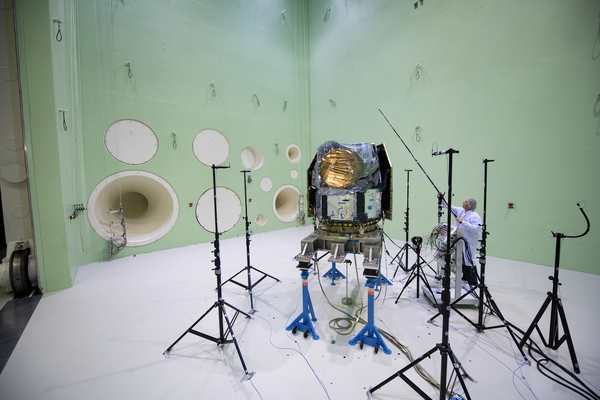 |
| The CHEOPS satellite surrounded by microphones used for acoustic noise testing. Credit: ESA–G. Porter |
Acoustic noise testing is necessary for satellites because loud sounds can be damaging. In the same way that an opera singer can shatter a wine glass by hitting the right note, the loud noise of ignition and launch has the potential to damage a spacecraft, especially if it causes any subcomponents of the satellite to vibrate at their resonant frequencies.
CHEOPS journal #13 reported on vibration testing that took place in Switzerland to ensure that mechanical vibrations do not damage the satellite at launch. Whereas mechanical vibrations during launch are transmitted to the spacecraft through an adapter fixed to the launcher, acoustic energy will reach the spacecraft through the air from all sides.
Acoustic noise testing was carried out in the test chamber of the Large European Acoustic Facility (LEAF) at ESA's European Space Research and Technology Centre, ESTEC, in the Netherlands, which is equipped with extremely powerful noise-generating horns. The 0.5-metre-thick, reinforced-concrete walls of the chamber are designed to reflect acoustic waves and fill the entire room with reverberant sound, creating a diffuse sound field in the vicinity of the satellite that recreates the conditions within the rocket's payload fairing at launch.
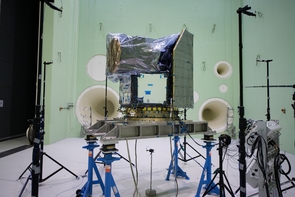 |
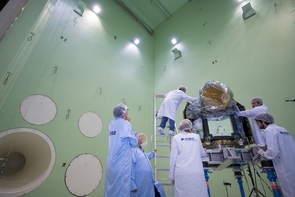 |
| The CHEOPS satellite in the Large European Acoustic Facility. Credit: ESA–G. Porter | Engineers in the LEAF facility working on the CHEOPS satellite. Credit: ESA–G. Porter |
The satellite was placed in an elevated position and surrounded by microphones that monitored sound pressure levels during the test. The response of the satellite to the sound field was recorded by fitting accelerometers to the spacecraft structure and measuring the mechanical vibrations induced by the acoustic waves. More than 18 accelerometers were used for the tests, including one that had been pre-installed on the telescope mirror, at the heart of the science instrument.
During the test, the satellite was subjected to the full spectrum of high sound levels expected at launch, and the state of the satellite before and after the test was compared. If high sound pressures cause damage to a test object, its vibrational response to lower, reference sound levels will change. For CHEOPS this was not the case, so scientists and engineers can now be confident that the acoustic noise requirement has been met. On this occasion, it was particularly important to qualify the fully integrated solar arrays equipped with solar cells, as the cells underwent acoustic testing for the first time.
| The CHEOPS satellite in the Large European Acoustic Facility. Click here for details and large versions of the video. Credit: ESA–A. Conigli; Airbus Defence & Space |
After acoustic noise testing, the spacecraft was transported to the Maxwell EMC facility, also at ESTEC. Electromagnetic compatibility testing had previously been performed at the equipment level and the subsystem level (see CHEOPS journals #5 and #7). The latest satellite-level EMC testing included both auto-compatibility tests, to show that radio emissions from onboard subsystems do not compromise the sensitive science measurements, and susceptibility tests, to ensure that the spacecraft systems are not adversely affected by radio emissions from external sources, for example transmitters on the launch vehicle or radars in and around the launch site. An everyday example of an electronic device being affected by electromagnetic interference is a car radio hissing and crackling when the car passes under electric tram lines.
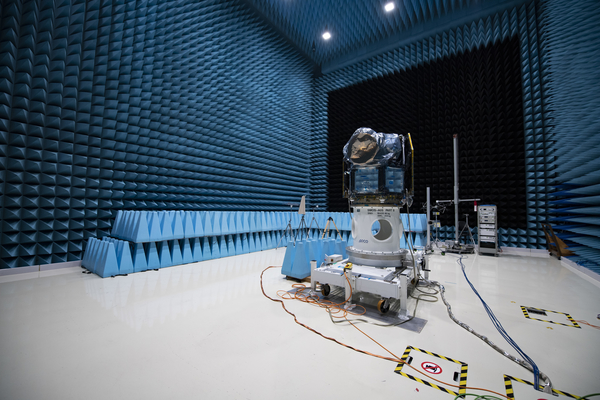 |
| The CHEOPS satellite in the Maxwell test facility. Credit: ESA–G. Porter |
The test chamber of the Maxwell EMC facility is designed using a different principle from the ones underlying the LEAF facility. Whereas the LEAF acoustic test chamber has reflecting walls to produce a reverberant sound field, EMC testing is performed in what is called an anechoic chamber, with walls that absorb radio waves and simulate an environment that, for what concerns radio emissions, is similar to that of outer space.
The absence of reflections is necessary to recreate the electromagnetic fields created by a two-way radio link between Earth and an orbiting satellite. It also allows the spacecraft to be irradiated from selected angles associated with, for example, transmitters on the launcher. For the recent susceptibility tests, three incident directions, corresponding to those for which the satellite is expected to be most susceptible to electromagnetic interference, were tested separately. In addition, the level of radio emissions generated by the CHEOPS satellite in its launch configuration was characterised during the test, in order to ensure that any radio emission produced by the satellite does not interfere with the launch vehicle.
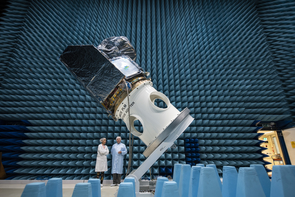 |
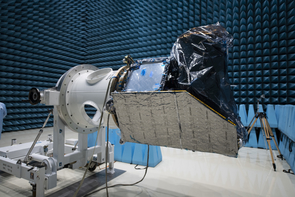 |
| Tilting and rotating CHEOPS for EMC testing. Credit: ESA–G. Porter | Tilting and rotating CHEOPS for EMC testing. Credit: ESA–G. Porter |
The satellite was mounted on a support that allowed it to be tilted and rotated, so that it could be irradiated by test antennas from different angles. Selected voltage, current and temperature readings from onboard sensors were monitored to ensure that the satellite was not unduly disrupted by the emissions of the test antennas, which covered the frequency range 10 kHz to 40 GHz.
For the auto-compatibility tests, it was important to ensure that the in-orbit operations of the satellite do not affect the science instrument. This was confirmed by acquiring images with the instrument's CCD under carefully controlled conditions. A tiny pinhole was used to allow light from a special lamp to enter the telescope tube and, while data was transmitted and received via radio link, the performance of the sensitive science instrument was monitored.
| The CHEOPS satellite in the Maxwell test facility. Click here for details and large versions of the video. Credit: ESA–A. Conigli; Airbus Defence & Space |
After a successful series of EMC tests, which complete the satellite's environmental campaign, CHEOPS left ESTEC for Airbus Defence and Space Spain in Madrid. In the remaining part of the year, the satellite will undergo a final set of tests before being declared ready for launch. Key activities will include the propulsion module leak check, the post-environmental campaign solar array tests, the measurement of the mass and moment of inertia, and the launcher fit check.
After installation of the latest flight software version, CHEOPS will be subjected to a number of functional tests at sub-system and system level, including the last of the planned System Validation Tests (see CHEOPS journals #4, #8, #10 and #12 for the previous tests), during which the spacecraft will be controlled from the Mission Operations Centre in Spain. The Qualification & Acceptance Review is expected to start in November and to be completed by February 2019, leading to the declaration of CHEOPS as 'fit-to-fly'.
The end of the pre-flight test campaign is now in sight and we can begin to look forward to writing a new chapter in our understanding of exoplanets.
About CHEOPS
CHEOPS is an ESA mission implemented in partnership with Switzerland, through the Swiss Space Office (SSO). The University of Bern leads a consortium of 11 ESA Member States contributing to the mission and represented in the CHEOPS Science Team. ESA is the mission architect responsible for overall mission definition and procurement of the spacecraft and launch. ESA is also responsible for the early operations phase that will be executed by the spacecraft contractor, Airbus Defence and Space–Spain (ASE). The science instrument is led by the University of Bern, with important contributions from Austria, Belgium, Germany and Italy. Other contributions to the science instrument, in the form of hardware or science operations, are provided by Hungary, France, Portugal, Sweden, and the United Kingdom. CHEOPS will be launched from Europe's spaceport in Kourou, French Guiana, on a Soyuz rocket operated by Arianespace. Following successful in-orbit commissioning of the spacecraft, responsibility for operations will be taken over by the CHEOPS Mission Consortium, with the Mission Operations Centre under the responsibility of INTA, Spain, and the Science Operations Centre led by the University of Geneva, Switzerland.





















